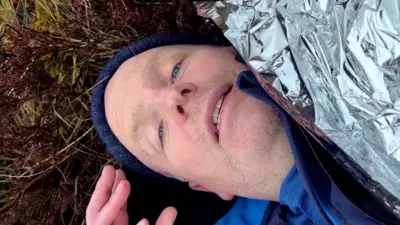We've updated our Privacy and Cookies Policy
We've made some important changes to our Privacy and Cookies Policy and we want you to know what this means for you and your data.
Amber-trapped lizard fossils reveal 'lost world'
Image source, Daza et al/Sci Advances
- Author, Helen Briggs
- Role, 91ČČąŹ News
Lizards locked in amber for 99 million years give a glimpse of a "lost world", say scientists.
The ancient reptiles are preserved in "superb detail" down to scales of skin, the tip of a tongue and tiny claws.
Two of the fossils are related to modern-day chameleons and geckos, revealing how features such as sticky toe-pads evolved.
The lizards inhabited tropical forests in what is now Myanmar during the Mid-Cretaceous Period.
Researchers in the US have published their assessment of the specimens in the journal .
"The fossilised amber provides a view into a lost world, revealing that the tropics of the Mid-Cretaceous contained a diverse lizard fauna," Dr Edward Stanley of the Florida Museum of Natural History told 91ČČąŹ News.
Image source, Daza et al/Sci Adv
Some of the lizards are representatives of modern groups such as geckos, while others have no modern equivalent and eventually died out.
One of the fossils appears to be a transitional form between the "standard" lizard form and chameleons, said Dr Stanley.
"This 'missing-link' is roughly 80 million years older than the next oldest chameleon fossil, and shows that features like the chameleon's projectile tongue was present deep in its ancestry," he added.
"But its strange fused toes (adaptations for climbing along branches) evolved later."
Snapshot of the past
The amber fossils were obtained by private collectors and were acquired by museums in the US. They have now been collated and studied for the first time.
"They provide details of external morphology, which is something that is pretty rare to find," said Juan Diego Daza, of Sam Houston State University in Texas, who led the research.
"These fossils represent most of the diversity of lizards with a superb amount of detail."
Image source, Daza et al/Sci Adv
Soft tissues and internal organs - as well as bones - can persist in amber for millions of years.
"We can pretty much see how the animals looked when they were alive," explained Prof Daza.
"They provide a really nice snapshot of the past. To me it is like going back in time and doing a lizard collecting trip when we can see what these animals looked like."
Some of the smaller specimens are whole lizards but others are fragments of animals.
Together, they could resolve some of the gaps in the family tree between ancient reptiles and their modern relatives.
Follow Helen on .
Top Stories
More to explore
Most read
Content is not available








